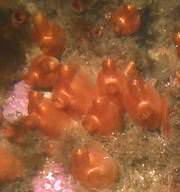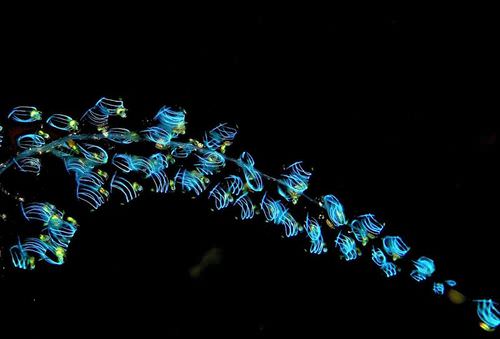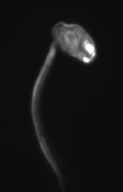15.47 学士 -- -- 高级
章节大纲
-
What's a tunicate?
::什么是礼仪?That's a good question. How would a scientist explain tunicates? Probably by their role as one of the last links (along with the lancelets) in the evolutionary from invertebrates to .
::问得好。科学家如何解释欺凌? 可能是因为他们的角色是 从无脊椎动物进化到无脊椎动物Tunicates
::受 教 语 语 语 语 语 语 语 语 语 语 语 语 语 语 语 语 语 语 语 语 语 语 语 语 语 语 语 语 语 语 语 语 语 语 语 语 语 语 语 语 语The subphylum Urochordata includes around 3,000 , commonly called tunicates, that reside in shallow waters. Adult tunicates, such as the ones shown in Figure , do not bear much resemblance to other chordates. Tunicates, however, are actually chordates and played an important part in the evolution of vertebrates .
::亚植物类乌罗乔尔数据包括居住在浅水中的大约3,000个通常被称为暴徒,如图中所示的成人暴徒与其他暴徒没有多大相似之处。 然而,暴徒其实是破碎的,在脊椎动物的进化中扮演了重要角色。A tunicate species of the subphylum Urochordata. It is difficult to imagine that these sessile animals, which almost looks like plants on the bottom of the ocean, are actually chordates. However, tunicates develop from larvae that have a notochord, a dorsal nerve cord, a post-anal tail, and pharyngeal slits, which are all features characteristic of chordates. As adults, most tunicates are sessile (they do not move around) filter feeders that lack a notochord and a post-anal tail . They also lack the body segmentation that is found in other chordates. However, tunicate larvae , such as the one shown in Figure , possess all four of the major distinguishing characteristics of chordates: a post-anal tail, a notochord, a dorsal nerve cord, and pharyngeal slits .
::成年后,大多数成年成年动物(它们不动)都具有色素(它们不动),没有 Notochord 和 annal 尾巴的过滤器饲料,也没有其他chorates 中发现的身体分解功能。 然而,像图中所示的幼虫一样,幼虫具有所有四个主要区别特征:后肛门尾巴、经销尾巴、经销神经索和阴道切除。The larva of a tunicate species. This larva has a notochord, a dorsal nerve cord, pharyngeal slits, and a post-anal tail. The adult tunicate body is shaped like a small barrel with two large openings called siphons. The inhalent siphon brings into a saclike, central cavity, called the atrial cavity (distinct from the coelom), and then through the pharyngeal slits where food is filtered into the . The water then exits the cavity through an exhalent siphon. The tunicate coelom is reduced to a small compartment surrounding the heart. The majority of the organs lie within a body cavity below the atrial cavity called the epicardium, or visceral cavity. The visceral cavity contains the digestive tract (except for the pharynx , which is situated in the atrial cavity), the heart, and the reproductive organs. The organization of the tunicate body is shown in Figure .
::成年牙形体的形状像一个小管子,有两个大开口,叫做吸孔。吸入式抽取液将一个类似神圣的中央腔,叫做胃腔(从科洛姆取出来),然后穿过将食物过滤到口腔的阴道切片。水然后通过排气吸管从口腔中流出。口腔被缩小为心脏周围的一个小区。大部分器官位于一个叫做中枢或内脏腔的体腔下部。内腔腔包括消化道(除位于科洛姆腹部的阴道外)、心脏和生殖器官。图中显示了胸腔体的组织。The organization of an adult tunicate body. The digestive system is outlined in green, the gonad is in purple, and the circulatory system is in red. Water is brought into the pharynx within the atrial cavity and through the pharyngeal slits via the inhalent siphon. Food particles captured by the pharyngeal slits are then passed into the remainder of the digestive system, situated in the lower cavity called the epicardium. The digestive system ends with an anus that opens back into the atrial cavity, and waste exits the body through the exhalent siphon. Tunicates are generally hermaphrodites that sexually reproduce by cross- . That means that an individual does not use its own to fertilize its eggs . Instead, they obtain sperm released into the open ocean by other individuals. Fertilization is usually internal. Tunicates can also undergo by budding . This method is frequently carried out by colonial species, with the newly budded organisms remaining attached to the colony. Tunicates have indirect development involving a larval stage. It is the tunicate larva that has most of the features commonly associated with chordates, including a notochord and a post-anal tail. The transition from free-swimming larvae to sedentary adults involves major anatomical changes in the . One very odd change is that the cerebral ganglion, located in the head region of the larval stage, is essentially consumed during metamorphosis . The sessile adult forms do not have a need for the same level of neuronal processing as the motile larval stages, and the head region is lost during metamorphosis.
::肿瘤通常是通过交叉方式进行生殖的雌性激素。这意味着一个人没有使用自己的生殖器来施肥卵。相反,他们得到的精子是由其他人释放到开阔的海洋中。 肥料通常是内部的。 授精也可以通过萌芽进行。 这种方法通常由殖民物种实施,新芽的有机体仍附着在殖民地中。 授精的间接发育涉及幼虫阶段。 幼虫的幼虫大部分特征通常与发酵过程有关, 包括一个通知和后尾巴。 从自由游泳的幼虫向定居成人的过渡涉及主要的解剖变化。 一种非常奇怪的变化是, 位于幼虫阶段的大脑团结基本上在畸形过程中被消耗。 成年形态不需要与月球阶段相同的神经化处理水平, 而大脑区域在变形过程中丢失。Tunicates derive their name from a thick extracellular body covering, called a tunic, that is made up of cellulose-like, complex sugars. Another interesting feature of tunicates is their . Instead of , the heart pumps through a number of small pockets called sinuses. In addition, the heart periodically changes the direction that it pumps blood.
::教义取自一个厚厚的外细胞体,叫做外细胞体,由类似纤维素的、复杂的糖组成。它的另一个有趣的特征是它。不是它,心脏泵通过一些小口袋,叫做鼻涕。此外,心脏定期改变它抽血的方向。There are four different classes within the urochordate subphylum:
::聚氨酯亚植物内有四种不同等级:-
Ascidiacea.
::阿斯西迪亚西亚 -
Thaliacea.
::泰利雅西亚 -
Larvacea.
::拉瓦塞亚 -
Sorberacea.
::索贝瑞莎
The class Ascidiacea is the largest class in the urochordate subphylum. They are generally sedentary organisms with all of the standard characteristics of tunicates described above. A member of the ascidiacean class is shown in Figure .
::Ascidiacea 类是泌尿素亚植物中最大的类,一般是具有上述所有顶部动物标准特性的固定生物。Tunicates of the class Ascidiacea. This is the largest class in the urochordate subphylum. It is comprised of sessile, filter-feeding animals that have pharyngeal slits as adults. Thaliaceans, shown in Figure , are free-floating, colonial urochordates commonly called salps. They propel themselves through the ocean using force generated by expelling water through the excurrent siphon, which is usually one opening shared by many members of a colony.
::图中显示的硫化物是自由漂浮的、殖民化的极土合金,通常被称为盐。 它们利用通过流水流流流流(通常由殖民地许多成员共享的流水流)将水排出而形成的力量在海洋中前进。 流水流通常是一个殖民地许多成员共享的开口。A colony of urochordate members of the class Thaliacea. Unlike the ascidians, thaliaceans are free-swimming organisms that often form colonies like the one shown in this picture. They are propelled by the force of water expelled from their siphons and muscle contractions. Species within the class Larvacea are also free-swimming urochordates, with a long tail that contains the notochord and dorsal nerve cord. A member of the Larvacea class is shown in Figure . In part because they retain the notochord and dorsal nerve cord as adults, and because they have a long tail, they look similar to the larval stage of Ascidiacea species like the one shown in the Figure .
::Larvacea 类中的物种也是自由游动的极地合唱团,长尾尾包括诺科多和领骨神经索。 Larvacea 类的一名成员在图中显示了这一点。 部分原因是他们保留了成年时的诺科多和领骨神经索,并且因为它们有长尾,它们看起来与Ascidiacea 物种的幼发阶段相似,就像图中显示的一样。A member of the urochordate class Larvacea. Notice the long tail that houses the notochord and a number of muscles. Compare the overall appearance of this organism to the larvae of the class Ascidiacea. The organism in this photograph contains a fluorescent protein within certain tissues, and the photograph was taken using special filters that show the locations of that protein. Sorberacea is a sedentary class of urochordates that differs from the other classes in that it includes predatory species that feed on other invertebrates such as .
::Sorberacea是一种固定的极地和弦类,不同于其他类别,因为它包括食用其他无脊椎动物的掠食性物种,例如。Summary
::摘要-
As adults, most tunicates are sessile (they do not move around) filter feeders that lack a notochord and a post-anal tail.
::作为成年人,大多数暴徒都是塞西里人(他们不动), -
Tunicate larvae have the characteristics that define chordates.
::Tunicate 幼虫具有界定染色体的特性。 -
Tunicates are generally hermaphrodites that sexually reproduce by cross-fertilization.
::通婚者通常是通过交叉授精进行性繁殖的雌性恋者。 -
Tunicates make up four different classes: Ascidiacea, Thaliacea, Larvacea, and Sorberacea.
::学生分为四类:Ascidiacea、Taliacea、Larvaciea和Sorberesa。
Review
::回顾-
Adult tunicates don't look like other chordates. What characteristics do they lack?
::成年人的礼仪看起来不像其他的礼服,它们缺少什么特征? -
How do tunicates reproduce?
::猥亵如何繁殖? -
What dramatic changes occur to tunicate larvae during metamorphosis?
::在变形期间,幼虫的发育会发生什么急剧的变化? -
How is the circulatory system of tunicates different from other animals?
::礼仪的循环系统 与其他动物有什么不同? -
Briefly describe the classes that are classified as tunicates.
::简要说明被归类为猥亵的类别。
-
Ascidiacea.






